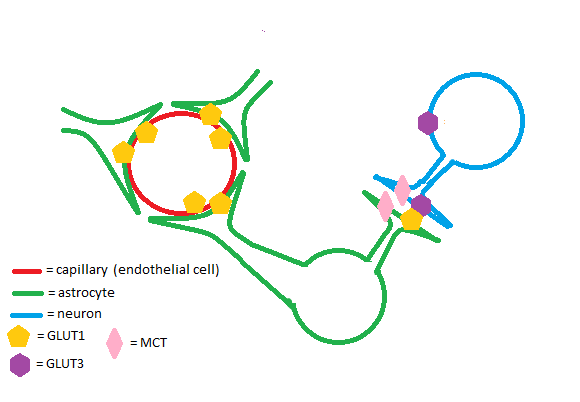Function
The GLUT1 is an insulin-independent glucose transporter expressed by all cells in the body to maintain adequate baseline glucose uptake. Tissues that express GLUT1 at high concentrations include (but are not limited to): the placenta and fetal tissues, epithelial cells of the retina and mammary gland, and the brain.[1]
Brain
The GLUT1 transporter works synergistically with other solute carriers in the brain. Astrocytes and endothelial cells of brain capillaries primarily express GLUT1; neurons primarily express Glut3. GLUT1 has a relatively high Km and is upregulated in times of hypoglycemia in the brain to ensure adequate glucose uptake. Glut3 has a low Km to ensure a steady supply of glucose for neurons even when extracellular glucose concentrations are low.[2]

Pregnancy
The GLUT1 transporter is highly expressed in both the placenta and the developing embryo/fetus.[3] During pregnancy, there is no significant fetal gluconeogenesis in humans.[4] High GLUT1 expression in the fetoplacental tissues ensures that the fetus receives a steady supply of glucose.
Retina
GLUT1 is the most abundant glucose transporter in the retina. Retinal pigmented epithelium and retinal capillary endothelium, the tissues that comprise the retina-brain barrier, express GLUT1.[5] The retina has a consistently high energy requirement due to abundance of ATPases such as Sodium-Potassium ATPase. Studies on mice have shown that GLUT1 knockout leads to photoreceptor cell death; a greater effect was noted in rod cells versus cone cells.[6]
Disease
Cancer
Oncogenes such as Ras and Src have been linked to upregulation of GLUT1 in rat tumors. Many studies have shown that GLUT1 is upregulated in malignancies of the breast.[7] Upregulation of the GLUT1 transporter has been shown to increase cell proliferation in some types of breast cancer.[8]
Relevance
Structural highlights
The GLUT1 transporter has one known site at Asn 45 and varied molecular weights of the GLUT1 transporter suggest glycosylation is dependent on cell type. This glycosylation site is thought to be important for glucose binding to the extracellular portion of the transporter. Mutations in the GLUT1 transporter from Asn 45 to an Asp, Tyr, or Gln residue have been shown to increase the Km of the enzyme.[9]
has a
References
- ↑ Pragallapati S, Manyam R. Glucose transporter 1 in health and disease. J Oral Maxillofac Pathol. 2019 Sep-Dec;23(3):443-449. doi:, 10.4103/jomfp.JOMFP_22_18. PMID:31942129 doi:http://dx.doi.org/10.4103/jomfp.JOMFP_22_18
- ↑ Koepsell H. Glucose transporters in brain in health and disease. Pflugers Arch. 2020 Sep;472(9):1299-1343. doi: 10.1007/s00424-020-02441-x. Epub, 2020 Aug 13. PMID:32789766 doi:http://dx.doi.org/10.1007/s00424-020-02441-x
- ↑ Illsley NP, Baumann MU. Human placental glucose transport in fetoplacental growth and metabolism. Biochim Biophys Acta Mol Basis Dis. 2020 Feb 1;1866(2):165359. doi:, 10.1016/j.bbadis.2018.12.010. Epub 2018 Dec 26. PMID:30593896 doi:http://dx.doi.org/10.1016/j.bbadis.2018.12.010
- ↑ Borges MH, Pullockaran J, Catalano PM, Baumann MU, Zamudio S, Illsley NP. Human placental GLUT1 glucose transporter expression and the fetal insulin-like growth factor axis in pregnancies complicated by diabetes. Biochim Biophys Acta Mol Basis Dis. 2019 Sep 1;1865(9):2411-2419. doi:, 10.1016/j.bbadis.2019.06.002. Epub 2019 Jun 5. PMID:31175930 doi:http://dx.doi.org/10.1016/j.bbadis.2019.06.002
- ↑ Liu H, Prokosch V. Energy Metabolism in the Inner Retina in Health and Glaucoma. Int J Mol Sci. 2021 Apr 1;22(7). pii: ijms22073689. doi: 10.3390/ijms22073689. PMID:33916246 doi:http://dx.doi.org/10.3390/ijms22073689
- ↑ Swarup A, Samuels IS, Bell BA, Han JYS, Du J, Massenzio E, Abel ED, Boesze-Battaglia K, Peachey NS, Philp NJ. Modulating GLUT1 expression in retinal pigment epithelium decreases glucose levels in the retina: impact on photoreceptors and Muller glial cells. Am J Physiol Cell Physiol. 2019 Jan 1;316(1):C121-C133. doi:, 10.1152/ajpcell.00410.2018. Epub 2018 Nov 21. PMID:30462537 doi:http://dx.doi.org/10.1152/ajpcell.00410.2018
- ↑ Macheda ML, Rogers S, Best JD. Molecular and cellular regulation of glucose transporter (GLUT) proteins in cancer. J Cell Physiol. 2005 Mar;202(3):654-62. doi: 10.1002/jcp.20166. PMID:15389572 doi:http://dx.doi.org/10.1002/jcp.20166
- ↑ Oh S, Kim H, Nam K, Shin I. Glut1 promotes cell proliferation, migration and invasion by regulating epidermal growth factor receptor and integrin signaling in triple-negative breast cancer cells. BMB Rep. 2017 Mar;50(3):132-137. doi: 10.5483/bmbrep.2017.50.3.189. PMID:27931517 doi:http://dx.doi.org/10.5483/bmbrep.2017.50.3.189
- ↑ Asano T, Katagiri H, Takata K, Lin JL, Ishihara H, Inukai K, Tsukuda K, Kikuchi M, Hirano H, Yazaki Y, et al.. The role of N-glycosylation of GLUT1 for glucose transport activity. J Biol Chem. 1991 Dec 25;266(36):24632-6. PMID:1761560

